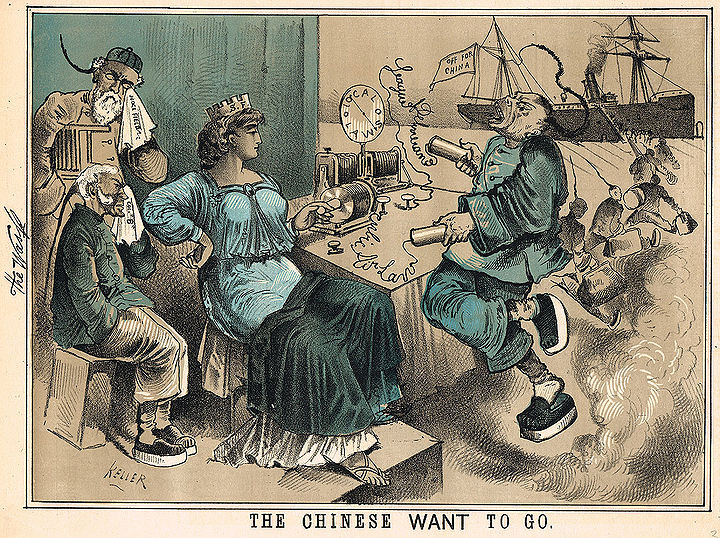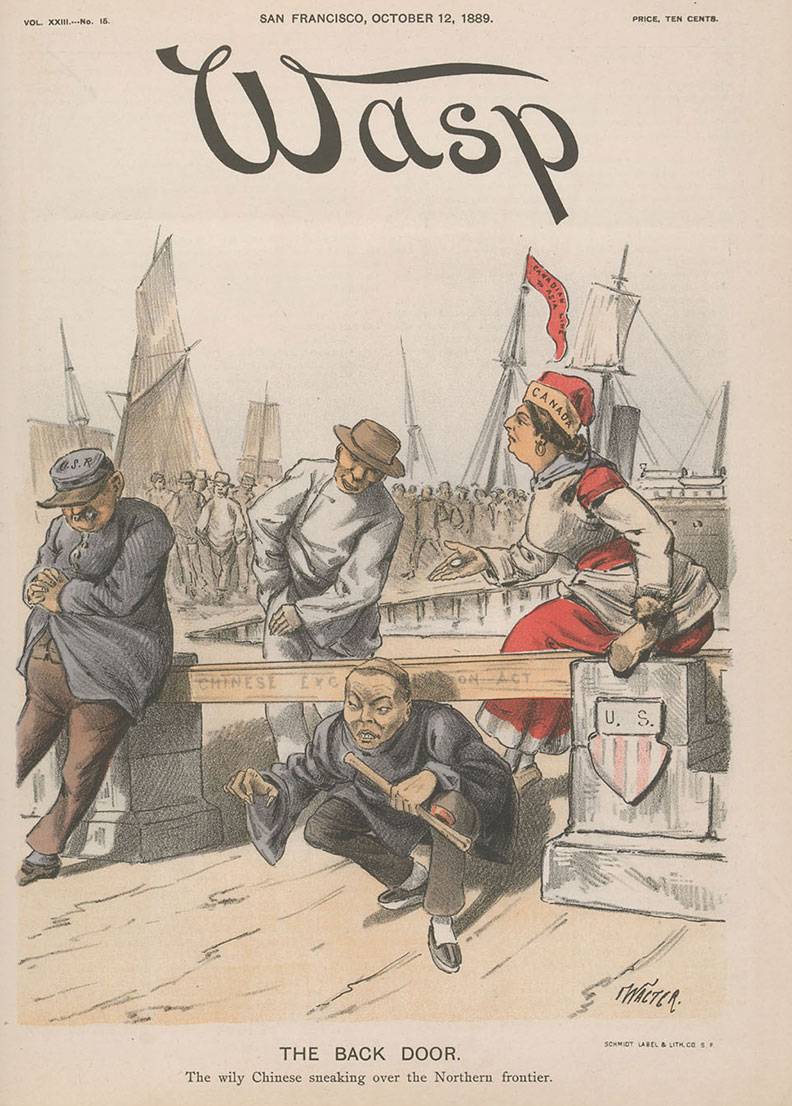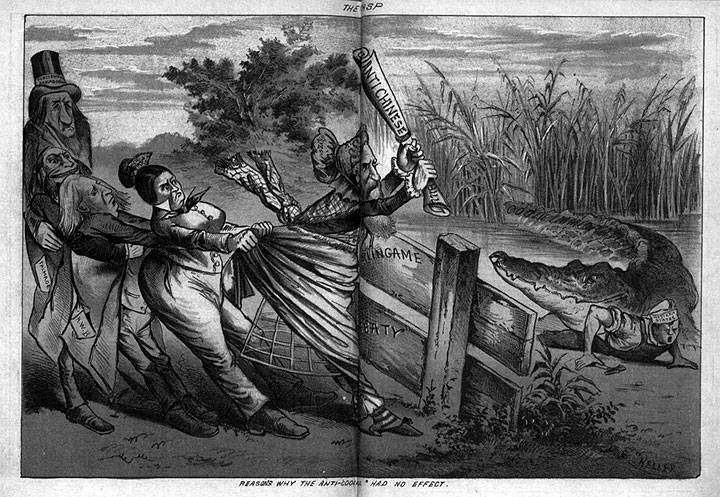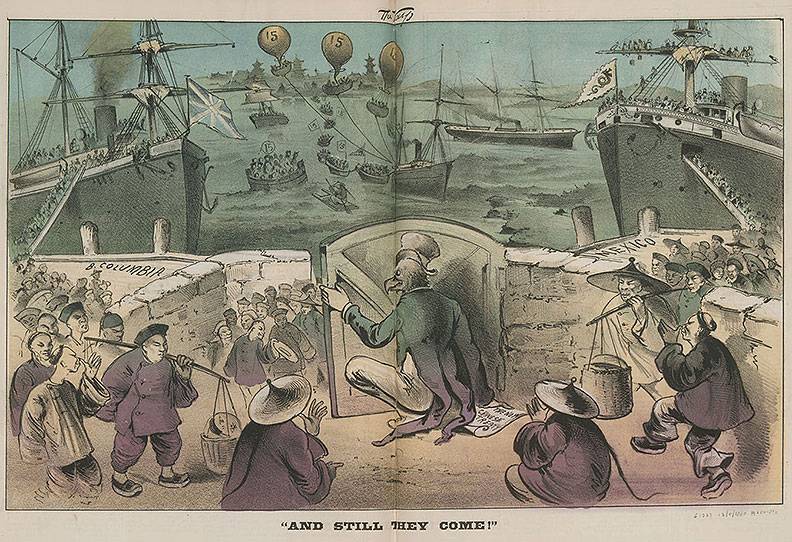WASP: The Case of the Chinese
Historical Essay
by Nicholas Sean Hall
Originally published as The Wasp's "Troublesome Children": Culture, Satire, and the Anti-Chinese Movement in the American West in California History, Vol. 90, No. 2 (2013); excerpted with permission. This is part two.
"The Chinese Want to Go", early 1880s, The Wasp
Image: Shaping San Francisco
As evidenced by the frequency and hysterical nature of their portrayal, however, no group—Indians and Mormons included—preoccupied the minds of the Wasp’s staff more than the Chinese. The issue became Korbel's principal concern following the publication's retreat from political partisanship. Keller dutifully channeled into his illustrations his employer's malaise with the two major political parties and their reluctance to address the Chinese threat. In the ensuing decades, the Chinese became the Wasp’s favorite target as it rolled off the presses each week.
California's ambivalent relationship with Chinese immigrants began almost as soon as they arrived at Gold Mountain, the name they gave to Gold Rush California. In San Francisco, city planners included the Chinese—wearing silk robes made in their native land—in a parade celebrating California's admission to the Union in 1850.(32) Two years later, Governor John McDougal suggested that California might use more laborers from China to help drain the state's swamplands. But migration gained considerable momentum during the following years, when the flow of Chinese migrants swelled from 325 forty-niners to 20,026 arrivals in 1852. In May of that year, the state legislature required that all foreigners without plans to naturalize pay a three-dollar annual tax. In reality, the tax was a thinly veiled handicap on all nonwhite or foreign competition for California's gold: Chinese, Mexican, Chilean, Hawaiian, Peruvian, and Argentinean.(33)
The lure of gold was not the only reason people in China were willing to indenture themselves to powerful merchants to cross the Pacific. Imperialism helped to push these immigrants onto ships. During the Opium Wars of 1839-42 and 1856-80, Britain had enforced, through force of arms, its right to sell opium to the people of China against the wishes of the Qing government. These wars resulted in indemnities to Western powers, creating a massive debt in China that the state attempted to ameliorate by imposing stifling taxes on its people. By the 1850s, many Chinese men sought more stable economic footing in the United States.(34) Even after the momentum of the Gold Rush began to wane, steamship companies and agents in China recruited laborers to meet the tremendous manpower needs in the developing American West.(35)
WASP Cover, 1889, depicting Chinese sneaking across Canadian border.
Image: Bancroft Library
Most famously, between 1865 and 1869, 10,000 Chinese workers provided a crucial labor force for the Central Pacific Railroad during its construction of the western segment of the transcontinental railroad.(36) California, unlike other regions where the Chinese settled, saw an arrival rate twice that of Anglo American immigrants during the 1870s. After the railroad's completion, many former workers banded together in urban enclaves (most notably in San Francisco's Chinatown) to protect themselves against violence by white vigilante groups that had continued since the Gold Rush.(37) They typically found employment similar to railroad work—menial, low-wage jobs, most commonly as domestics or launderers—performing much of the dirty, dangerous but necessary work required to support growing populations.(38)
Many of San Francisco's European and European American citizens already viewed the Chinese as the nonwhite "other," the antipode to their own position in society.(39) The foreignness of Chinese immigrants' dress, language, and culture came to embody all that white San Franciscans defined as anathema to their American identity. When the bottom dropped out of the economy, their anger exploded. The Panic of 1873, spawned by the insolvency of Jay Cooke & Co. (one of the federal government's primary Civil War financiers), coupled with speculation in Virginia City's Comstock Lode, sent ripples of economic downturn to San Francisco, raising resentment of Chinese immigrants to new heights. Prior to the Depression, because the Chinese had found work in thankless, low-wage jobs, whites did not perceive them as a threat to their economic well-being. But by the mid-1870s, as the city's number of unemployed white men grew, so too did their animosity toward Chinese workers. The missionaries and racial radicals who had once been the sole allies of California's Chinese now capitulated to the popular anti-Chinese tide and withdrew their support.(40) Under such conditions, the West Coast became a cauldron of anti-Chinese antipathy, racism, and violence.
The 1877 restoration of white supremacy to the South marked an opportunity for the state's antiChinese movement to solidify and take on new momentum. Californians seized the opportunity to insert their brand of white supremacy into highly contested debates about race in post-Civil War America. The Wasp consistently lamented what it perceived as a lack of sympathy in the eastern United States for the invasion by "Chinese hordes" on the Pacific Coast. The weekly maligned Hayes throughout his presidency for ignoring the outcry against the continued importation of Chinese coolie labor. Although the Wasp mocked a number of marginal groups, its cartoonists expended a disproportionate amount of effort ridiculing the Chinese and those deemed complicit in their continued arrival on the West Coast.
One of the leading sources of the anti-Chinese movement stemmed from the ideology of free labor, a significant political vehicle in the decades leading up to the Civil War. Although whites in the West tended to subsume all Chinese under the rubric of coolie labor, most Chinese immigrants lived as free individuals to a greater or lesser extent.(41) The white exclusionist movement utilized "free labor" ideology to conflate coolies with voluntary Chinese immigrants, who, while exploited, underpaid, and often trapped in cycles of debt, controlled their destination and negotiated the terms of their labor contracts. The former often journeyed to the United States on a credit-ticket system, making many voluntary Chinese immigrants more analogous to European indentured servants than the "slave" label that the western anti-Chinese movement so readily attached to them. In all its cartoons on the "Chinese question," the Wasp never distinguished between voluntary and involuntary immigration from across the Pacific.
Reasons Why the Anti-Coolie Bill Had No Effect, March 15, 1879
Image: Bancroft Library
In March 1879, the Wasp published Reasons Why the Anti-Coolie Bill Had No Effect in response to Hayes's veto of a congressional bill that would have prevented U.S.-bound Chinese ships from carrying more than fifteen passengers.(42) In the cartoon, Hayes, wearing women's clothing, futilely attempts to beat back an enormous crocodile ("Coolie Immigration") with a rolled paper ("Anti Chinese Bill"). A fence ("Burlingame Treaty," an 1868 agreement giving China "most favored nation status" and guaranteeing free immigration of the Chinese to the United States) prevents Hayes from keeping a white workingman, wearing a hat ("western states") from the jaws of a crocodile in its natural habitat, the wetlands. Though no crocodiles lived in sloughs on the Pacific coast, the reference to the work of so many Chinese laborers in their work for agribusiness firms converting California's marshlands into farmland is clear.
Others also keep Hayes from beating back the crocodile: his wife, Lucy, wearing men's clothing (Mrs. Hayes earned a reputation for her influence over her husband, having converted him to the abolitionist cause prior to the Civil War); Henry Ward Beecher, the liberal pastor of Boston's Plymouth Church; Thomas De Witt Talmage, whose dramatic style at the pulpit of New York's Central Presbyterian Church in Brooklyn drew crowds rivaling Beecher's; and a pilgrim, identified by his hat as a "Puritanical Demagogue."
What positions had earned these East Coast individuals the ire of the West Coast's virulently anti-Chinese publications? In his veto message, Hayes had tried to soothe angry Californians by claiming that their problem was one "deserving of the most serious attention of the people of the whole country, and a solicitous interest on the part of congress and the executive." However, he reasoned, international obligations ("articles 5 and 6 of the treaty with China, commonly called 'the Burlingame treaty'") outweighed the alleged threat the Chinese posed to republicanism in the Far West.(43)
For his part, Beecher—his reputation sullied by his infamous trial for adultery in 1875—had long held a tolerant attitude toward the Chinese. In a lecture on their immigration a month after the Wasp published its cartoon, he argued that "the Chinaman does not send to China the railroads he has helped to build, or the improvements he has helped to make in the soil and in the industrial facilities of the country."(44) The reverend mocked Californians' complaint that the Chinese had rebuffed all attempts to convert them to Christianity, quipping, "Well, we have clubbed them, stoned them, burned their houses and murdered some of them—yet they refuse to be converted. I don't know any way except to blow them up with nitroglycerine if we are ever to get them to Heaven."(45)
Talmage, whose repute as a lecturer earned him both fame and wealth, preached to his flock that "underground life in New York is 50 percent worse than Chinatown in San Francisco." He refuted the argument that the Chinese contributed little or nothing to California's economy, pointing to the taxes they paid to the government and the rent they remitted monthly to San Francisco's landlords. And as to the veracity of claims about the alleged "menace" threatening California, Talmage was unconcerned. "The Chinese scare," he declared, "is the greatest humbug that has ever been enacted."(46)
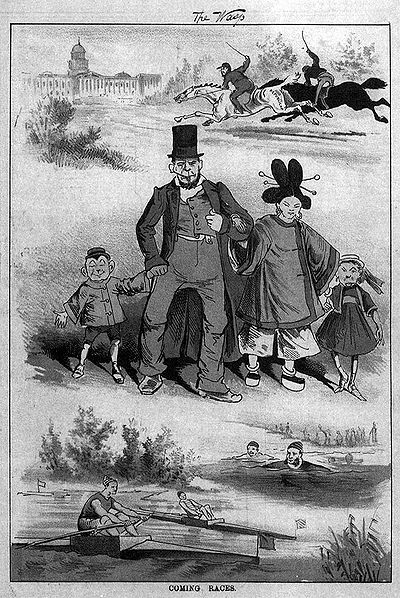
Coming Races, June 26, 1880
Image: Bancroft Library
The gender confusion and cross-dressing used by the cartoonist to portray the president and First Lady was a popular comedic trope in nineteenth century culture.(47) In this image, Hayes's feminization exemplifies white California's exasperation with the federal government's inability to protect western states. Keller also portrays the First Lady, who had worked extensively with the Methodist Missionary Society, as literally "wearing the pants" in her marriage, pulling Hayes away from his responsibility to protect American citizens. Eastern moralists and politicians simply did not comprehend western problems and encouraged the government to put off dealing with them.
Other illustrations suggest that the Wasp shared the nineteenth-century fear of miscegenation. In Coming Races, the satirist's play on the word races pits two definitions of the term against each other. Images in the cartoon's lower and upper portions portray actual races—a horse race, a swimming match, and a rowing race. In the center, a multiracial family composed of an Irish father, a Chinese mother, and two seemingly deformed and apelike children figure most prominently. Coupled with the lighthearted wordplay is the disconcerting portrayal of mixed-race children. Here, satire serves as admonition as well as reproach concerning the dire consequences of interracial union.
The message's salience becomes all the more significant when considering that antimiscegenation ideology, based on the absolute imperative to protect white, feminine domesticity, helped make legitimate a reign of terror against Southern black men. The cartoon shows a white-Chinese couple in lieu of a black-white interracial union and reverses the gender roles of the dominant anti-miscegenation discourse. Curiously, it posits an unlikely union, as the vast majority of Chinese immigrants who arrived in California were men. Most of the women were kidnapped prostitutes. The remainder were typically wives whose marriages had been arranged in China. The likelihood of a marriage between an Irish man and a Chinese woman in late nineteenth-century California would have been slim at best.(48)
And Still They Come...
Image: Online Archive of California
part one... "Racism and Satire in the 19th Century
Notes
31. In re Ah Yup, Circuit Court, District of California, 1 F. Cas. 223; 1878 Cal. LEXIS 1593• April 1878; for an extended reflection on the intellectual and legal implications of the case, see Ian F. Haney Lopez, White by Law: The Legal Construction of Race (New York: New York University Press, 1997).
32. Kevin Starr, California: A History (New York: Modern Library, 2005). 97-98.
33. Ronald Takaki, Strangers from a Different Shore: A History of Asian Americans (New York: Little, Brown, & Co., 1998) , 79-83.
34. Chinese women also came to the United States, though nearly all were involuntary migrants brought to American by exploitative businessmen. For more information, see Judy Yung, Unbound Feet: A Social History of Chinese Women in San Francisco (Berkeley: University of California Press, 1995). • 35 Karen Leong, The China Mystique: Pearl S. Buck , Anna May Wong, Mayling Soong, and the Transformation of American Orientalism (Berkeley: University of California Press, 2005). 8.
36. Saxton, The Indispensable Enemy, 4.
37. These anti-Chinese pogroms have been well detailed by Pfaelzer, Driven Out.
38. Deverell, Railroad Crossing, 36.
39. This argument was originally put forth by Alexander Saxton in The Rise and Fall of the White Republic: Class Politics and Mass Culture in Nineteenth Century America (New York: Verso, 1990).
40. See Paddison, American Heathens, especially chapters 5 and 6.
41. For an excellent treatment of the growth of the free labor ideology, see Eric Foner's classic Free Soil , Free Labor, Free Men: The Ideology of the Republican Party before the Civil War (New York: Oxford University Press, 1995). For more on the term "coolie" and its implications, see Ngai, "Western History and the Pacific World." Moon-Ho Jung's Coolies and Cane: Race, Labor, and Sugar in the Age of Emancipation (Baltimore: John Hopkins University Press, 2006), a study of the Chinese in Louisiana during Reconstruction, looks at the designs of antebellum planters to use Chinese coolies—already used in the Caribbean—to fill the agricultural labor vacuum should emancipation occur. For other studies of the Chinese outside the American West, see Lucy M. Cohen, Chinese in the Post-Civil War South: A People without a History (Baton Rouge: Louisiana State University Press, 1984); James W. Loewen, The Mississippi Chinese: Between Black and White (Cambridge: Harvard University Press, 1971); Shih-shan Henry Tsai, "The Chinese in Arkansas," Amerasia Journal 8 (1981): 1-18; Arthur Bonner, Alas! What Brought Thee Hither?: The Chinese in New York , 1800-1950 (Madison: Fairleigh Dickinson University Press, 1997).
42. Saxton, The Indispensable Enemy, 36-37.
43. Hayes' veto message printed in The Boston Globe, Mar. 2, 1879.
44. It was common in the nineteenth century to totalize "problem groups" under one supposedly unifying moniker—Americans often used "the Chinaman" or "John" when referring to the Chinese.
45. New York Tribune, Mar. 20, 1879.
46. New York Tribune, Sept. 20, 1880.
47. For instance, Mark Twain in his masterpiece The Adventures of Huckleberry Finn, which contains an instance where the title character tries (unsuccessfully) to pass himself off as a girl; Mark Twain, The Adventures of Huckleberry Finn (London: Piccadilly, 1884).
48. For more on antimiscegenation legislation in the West, see Peggy Pascoe, What Comes Naturally: Miscegenation Law and the Making of Race in America (New York: Oxford University Press, 2010).

